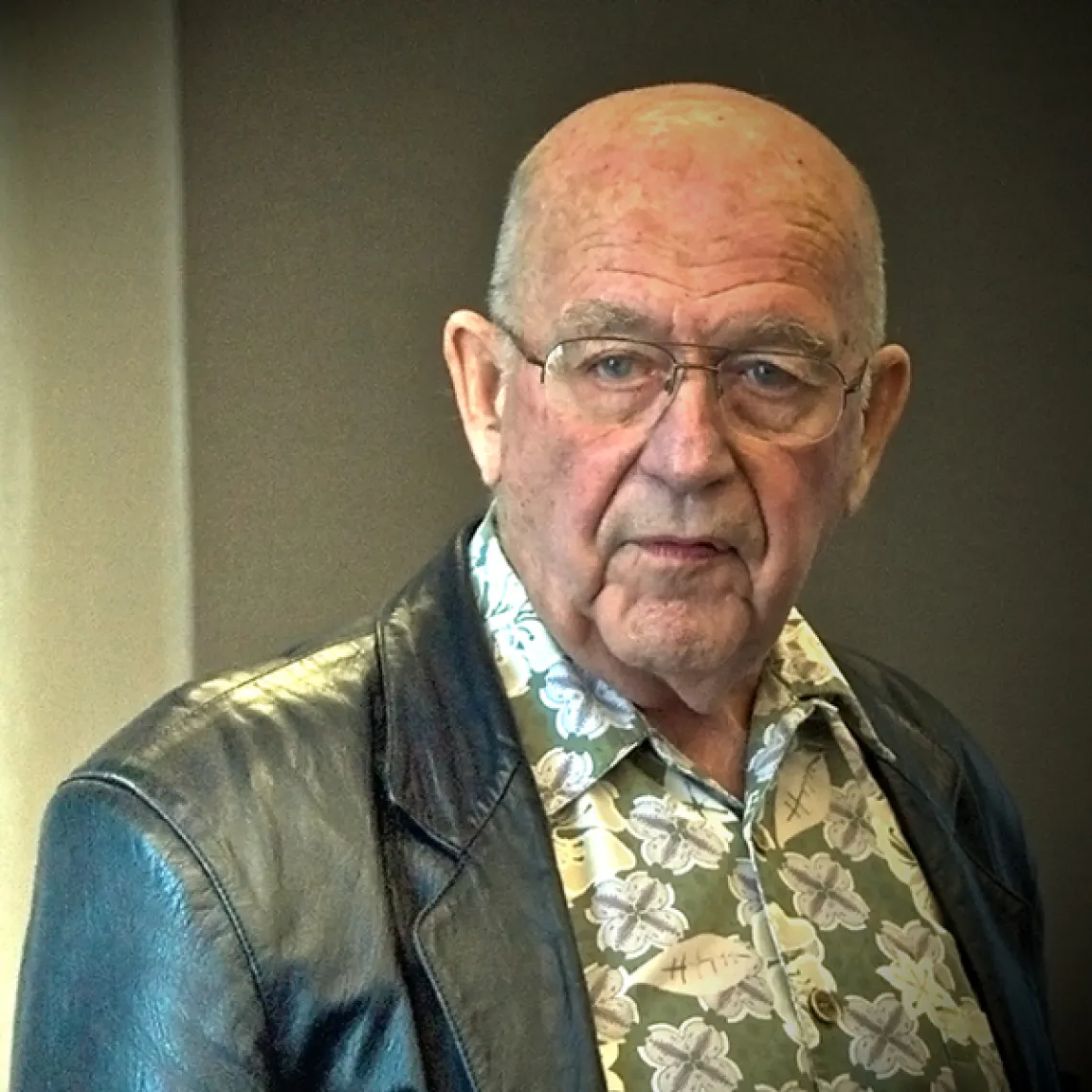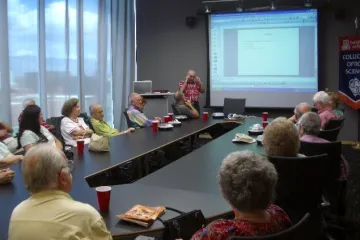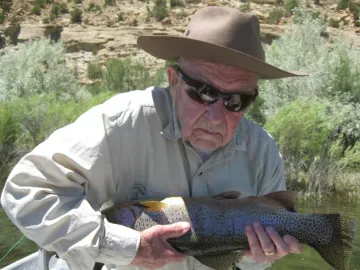Historical Lens: Optics Made Clear - Sharing the Fun and Wonder

I have spent fifty years of my professional life up to my eyeballs in optics. It has been delightful. It has been enlightening. It has brightened my life.
(William L. Wolfe, “Optics Made Clear,” SPIE Press, 2007)
Often when I have an idea for a Historical Lens article, I spend time perusing and gathering notes from the College’s archive of the newsletter, OSCillations, from the 1970s and 80s. Preparation for this article was no different—I typed in Professor Emeritus William (Bill) L. Wolfe’s name and began reading. But—after several pages of notes, with no end in sight—I decided to abandon the search and just start writing.
Over the course of Bill's distinguished and extensive career at the College of Optical Sciences (OSC), from 1969 to 1995, he engaged in a variety of activities including research, supervising graduate students, teaching, publishing numerous journal articles and co-authoring four editions of “The Infrared Handbook.” But equally impressive was his commitment to public engagement—providing learning opportunities to lay audiences through public lectures and educational presentations.
One of Bill’s first incentives to introduce the broader local community to OSC’s innovative and exciting research in the broad field of optics was the usual response he received when introducing himself to someone new. “It usually went something like this, what do you do? I am a professor. What do you teach? Optics. Blank face.”
Bill’s second incentive stemmed from the subsequent part of that introduction, when he would then be asked where he taught. “The Optical Sciences Center at the University of Arizona. Is that part of the physics department?” The final push came in 1989, during Bill’s tenure as president of SPIE. “One evening at my home in Tucson, I had a nice conversation with Mikhail Miroshnikov, the then-director of Leningrad’s State Optical Institute (GOI). I was congratulating him on the success of GOI when he interrupted me and said, but you guys are better!”
Over time—and after many similar incidents—Bill began to feel as if he was in a field that no one knew about and working for a Center that was the best in the world but few knew about. So, he thought, “why not tell them?” Before retiring from OSC in 1995, Bill had regularly participated in a series of Public Evenings designed for the interested layperson. This monthly event was jointly sponsored by OSC and the Tucson Section of the Optical Society of America (OSA), and featured talks and demonstrations from many of the Center’s early faculty, including—along with Bill—Professors Aden Meinel, Roland Shack, Steve Jacobs, Jack Gaskill, Harry Barrett and Peter Franken. This schedule from the 1974-75 academic year, was typical of the variety of topics presented.
-
October 28, 1974, Peter A. Franken, What Goes on at the Optical Sciences Center? The Optical Sciences Center has assumed a pioneering role in modern optical technology, including the construction of powerful telescope optics, the advancement of new laser techniques, the processing of medical and planetary imagery, and many breakthroughs in design.Image

- November 25, 1974, R. V. Shack, Zen in the Art of Image Formation. Most of us approach the images we observe with a preconceived idea of what we should see. New experiences await one who can learn to see with an innocent eye.
- January 13, 1975, A. B. Meinel, The Optics of Diamonds. Anyone who has purchased, worn, or admired cut diamonds has, albeit unwittingly, pondered questions of optics. Dr. Meinel will explore the history of diamonds and their fabrication into gems.
- February 10, 1975, W. L. Wolfe, Infrared Techniques in Diagnostic Medicine. The Optical Sciences Center and U of A Medical School are investigating improved methods of thermography and its use as a tool in detecting breast cancer. Fundamental principles will be explained and a demonstration will be given.
- March 10, 1975, H. Barrett, Moiré for Pun and Profit. The moiré effect—the shimmering pattern of wavy lines seen when two pieces of gauze are overlaid or a TV announcer wears a pinstripe jacket—has artistic, scientific, and engineering applications. The presentation will include a series of demonstrations with audience participation.
- April 7, 1975, W. Swindell, Pioneer 10 and 11—First Pictures from Jupiter. Pioneer 10 was the first spacecraft to traverse the unknown hazards of the Jovian radiation belt. By this date, Pioneer 11 also should have returned a large number of photos. Dr. Swindell will show the latest pictures and explain how they were obtained.
After retirement and becoming Professor “Meritless,” as he likes to joke, Bill wrote four technical books: two on infrared system design, one on imaging spectrometers, and one on radiometry. He has also written two books with the lay audience in mind. “Optics Made Clear,” (SPIE Press, 2007) was Bill’s attempt to “describe many of the natural phenomena caused by light—and the optical devices that use it—in terms everyone can understand.” And in “Rays, Waves and Photons,” (Green Ivy, 2015), Bill chronicles “the history of the development of our knowledge of light and its many applications.”
I started by considering how much optics is a part of our lives that we usually just ignore. I thought about the start of my day. I have a clock projected on my ceiling that works when it is dark enough. It is very convenient to just look up to get the time. As light dawns and it dims, I look over at the LED clock on my wall. When I get up, I look in the full-length mirror to see how I am dressed, and I used to use a convex mirror for shaving (until I let my beard grow). I turn on the lights if needed. My microwave oven has little LED indicator lights. Somebody turns on the light in my refrigerator when I open the door. There is an indicator light on my range to show when an electric burner is hot. I usually check my computer for messages looking at the array of LED’s on the screen. I do not think of the optical lithography that enabled the printed circuits that enabled my computer. I also am unmindful of the solar panels on my roof providing me electricity. I check the weather by looking through my double pane insulated windows. And, all of that is before I leave the house.
Once outside, my car has headlights, taillights, turn signals, display lights, rearview convex side mirrors and central rearview flip mirrors. It has laminated safety glass for a windshield and tempered glass for the side windows. Some later models have optical cables from the brakes to the display panel. Way before I bought the car, it was assembled by robots that used lasers and cameras for positioning. My smartphone that I can use to guide me to an unfamiliar place has a LED display and uses GPS satellites that are corrected for relativistic effects of speed and gravity. To better read the road signs, I may wear my bifocals, trifocals, variables or contact lenses. I greatly felt people needed to be made aware of all this optics in their everyday lives.
In addition to enlightening the public through written word, Bill has been (and still is) an energetic spokesman for the field of optics and OSC. What started with a request from his Homeowners Association quickly spread to include invited lectures at the Foothills Forum, various Rotary Clubs, Academy Village and Osher Lifelong Learning Institute. “People are amazed to learn that the optics industry is responsible for about $4.5 billion yearly of Tucson’s economy, and that most of OSC’s $30 million yearly budget comes from outside sources. That is an enormous Return on Investment (ROI) for Arizona taxpayers!”
Some time ago the energetic president of our Homeowners Association initiated a series of talks by residents on their favorite topics. I think that was the first time I gave a talk to a group of laypeople about optics, outside of OSC. I thought about what would grab them, and my first thought was all of the beautiful optics in nature—blue skies, red sunsets, rainbows and that kind of stuff. That was the first lecture. Then all the wonderful optical gadgets we have—mirrors, lenses, telescopes, microscopes, spectacles and more. In my next lectures, I started to include the origin of quantum mechanics—which was infrared optical—and relativity which depended upon the speed of light for its explanation. Then remote sensing, astronomical telescopes, spy satellites and more. It was a go!

At the “chronological age of 89, but the spiritual age of 23,” Bill shows no signs of slowing down in his quest to educate the general public about the fun and wonder of optics (and fly-fishing). He currently has three new writing projects underway. The first is a book on the history of optics, tracing the origin of each area of optics (e.g., optical design, infrared and relativity). The second, tentatively titled “Concepts of Contemporary Optics,” is a treatment of all aspects of optics—diffraction, refraction, reflection, etc.—without a single equation. And, the third,“40 Fabulous Fly-Fishing Lodges,” will highlight Bill’s favorite spots to “catch and release an incredible number of gorgeous trout”—and is a follow-up to his already published book, “40 Fun-Filled Float Trips for Fly Fishers” (Mill City Press, 2019)
